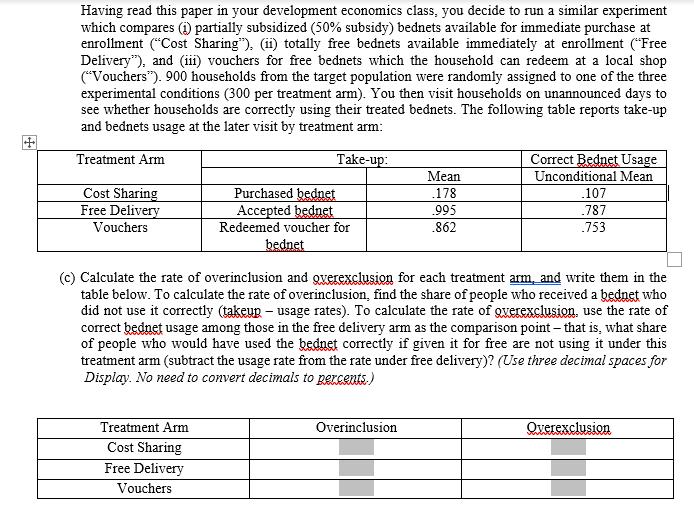Question
(c) Calculate the rate of overinclusion and overexclusion for each treatment arm, and write them in the table below. To calculate the rate of overinclusion,

(c) Calculate the rate of overinclusion and overexclusion for each treatment arm, and write them in the table below. To calculate the rate of overinclusion, find the share of people who received a bednet who did not use it correctly (takeup – usage rates). To calculate the rate of overexclusion, use the rate of correct bednet usage among those in the free delivery arm as the comparison point – that is, what share of people who would have used the bednet correctly if given it for free are not using it under this treatment arm (subtract the usage rate from the rate under free delivery)? (Use three decimal spaces for
Display. No need to convert decimals to percents.)
+ Having read this paper in your development economics class, you decide to run a similar experiment which compares (1) partially subsidized (50% subsidy) bednets available for immediate purchase at enrollment ("Cost Sharing"), (ii) totally free bednets available immediately at enrollment ("Free Delivery"), and (iii) vouchers for free bednets which the household can redeem at a local shop ("Vouchers"). 900 households from the target population were randomly assigned to one of the three experimental conditions (300 per treatment arm). You then visit households on unannounced days to see whether households are correctly using their treated bednets. The following table reports take-up and bednets usage at the later visit by treatment arm: Take-up: Treatment Arm Cost Sharing Free Delivery Vouchers Purchased bednet Accepted bednet Redeemed voucher for bednet Treatment Arm Cost Sharing Free Delivery Vouchers Mean .178 .995 .862 (c) Calculate the rate of overinclusion and overexclusion for each treatment arm, and write them in the table below. To calculate the rate of overinclusion, find the share of people who received a bednet who did not use it correctly (takeup - usage rates). To calculate the rate of overexclusion, use the rate of correct bednet usage among those in the free delivery arm as the comparison point that is, what share of people who would have used the bednet correctly if given it for free are not using it under this treatment arm (subtract the usage rate from the rate under free delivery)? (Use three decimal spaces for Display. No need to convert decimals to percents.) Overinclusion Correct Bednet Usage Unconditional Mean .107 .787 .753 Overexclusion
Step by Step Solution
3.42 Rating (158 Votes )
There are 3 Steps involved in it
Step: 1
ANSWER Table format for the calculation of overinclusion and overexclusion rates T...
Get Instant Access to Expert-Tailored Solutions
See step-by-step solutions with expert insights and AI powered tools for academic success
Step: 2

Step: 3

Ace Your Homework with AI
Get the answers you need in no time with our AI-driven, step-by-step assistance
Get Started


